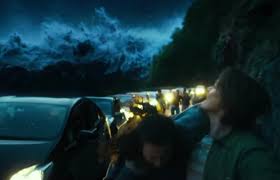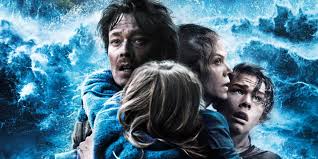One of the most compelling things about writing about films or learning about them generally is the ability to speak with or listen to the film makers first hand about their ideas.
In this case, the director, Roar Uthaug, hints at both the realism and the fiction, in his newly released Norwegian film: 'The Wave'.
Within the aspect of fiction, we note the horror element in one of the more emotionally powerful scenes. It borders on 'science fiction' when the mother (main female protagonist) is forced to kill the 'crazed' man trapped with her and her son under the rubble as water starts gushing into their confined space and threatens to drown them all.
The horror element here is portrayed through an enhanced male voice pitch; through the sound of the man's voice, as he gets worked up about their situation, and before he gets strangled by the boy's mother who is protecting her son.
The man's voice in this scene borders on being an insane Gothic character's voice.
We sense that his tone and pitch change and deepen as the voice vibrates with anger or aggression and as his mind succumbs under pressure.
The film's realism comes through with the research, whereas the fiction is felt because of the play of 'dark' and 'light' in the images on screen.
The research has obviously allowed the director to provoke a powerful image of the possible tsunami in the audience's mind, and it exposes both the scientific as well as the human consequential aspects of such a horrific event unfolding.
From a scientific point of view, the movie gives us a bird's eye view of the chain reaction which would lead to this natural upheaval.
It also makes us feel with the victims who either escape or suffer death because of this.
The director achieves the latter through creating a connection with a heroic family and through allowing the audience to identify with their strong ties to one another.
The film distinguishes itself from that point of view because the family has no internal issues to resolve as would usually be the case with the Hollywood disaster movie scenarios.
The only conflicts to resolve are external ones; essentially dealing with the effects of the tsunami.
The enemy in this case is nature's wildness and unpredictability.
The acting is intense and the close ups are very effective. The performances are made all the more 'real' because the filming takes place mostly in 'real time' with very few digital effects.
There are in fact very few digitalised special effects, which makes the action scenes more difficult but also look more believable.
The few long shots are of the huge waves, and those were the only digitalised images according to the director. As the leading actress mentions at the Q and A following the screening: some of the work was 'painful' because of having to be wet and work within the water a lot of the time in order to simulate drowning. The stunts were mostly actual.
This 'real time' acting and the research done for the film, give the production realism.
The sound effects, enhanced voice pitches and tones, as well as the play of 'shadows' with 'light', give it fictional value.
But because the film feels very 'actual', the ending has to be a happy one on some basic level, otherwise the film would be too 'real' or it would feel like the natural disaster has already taken place, and this would take away from the genuine aspect of the movie.
Fortunately, and according to the director, if this were real life, the experts would be able to predict the countdown to the flood earlier on, and thus fatalities would not be a consideration.
This film has certainly taken a majority of it's audience by 'storm', if you will excuse the pun.


In this case, the director, Roar Uthaug, hints at both the realism and the fiction, in his newly released Norwegian film: 'The Wave'.
Within the aspect of fiction, we note the horror element in one of the more emotionally powerful scenes. It borders on 'science fiction' when the mother (main female protagonist) is forced to kill the 'crazed' man trapped with her and her son under the rubble as water starts gushing into their confined space and threatens to drown them all.
The horror element here is portrayed through an enhanced male voice pitch; through the sound of the man's voice, as he gets worked up about their situation, and before he gets strangled by the boy's mother who is protecting her son.
The man's voice in this scene borders on being an insane Gothic character's voice.
We sense that his tone and pitch change and deepen as the voice vibrates with anger or aggression and as his mind succumbs under pressure.
The film's realism comes through with the research, whereas the fiction is felt because of the play of 'dark' and 'light' in the images on screen.
The research has obviously allowed the director to provoke a powerful image of the possible tsunami in the audience's mind, and it exposes both the scientific as well as the human consequential aspects of such a horrific event unfolding.
From a scientific point of view, the movie gives us a bird's eye view of the chain reaction which would lead to this natural upheaval.
It also makes us feel with the victims who either escape or suffer death because of this.
The director achieves the latter through creating a connection with a heroic family and through allowing the audience to identify with their strong ties to one another.
The film distinguishes itself from that point of view because the family has no internal issues to resolve as would usually be the case with the Hollywood disaster movie scenarios.
The only conflicts to resolve are external ones; essentially dealing with the effects of the tsunami.
The enemy in this case is nature's wildness and unpredictability.
The acting is intense and the close ups are very effective. The performances are made all the more 'real' because the filming takes place mostly in 'real time' with very few digital effects.
There are in fact very few digitalised special effects, which makes the action scenes more difficult but also look more believable.
The few long shots are of the huge waves, and those were the only digitalised images according to the director. As the leading actress mentions at the Q and A following the screening: some of the work was 'painful' because of having to be wet and work within the water a lot of the time in order to simulate drowning. The stunts were mostly actual.
This 'real time' acting and the research done for the film, give the production realism.
The sound effects, enhanced voice pitches and tones, as well as the play of 'shadows' with 'light', give it fictional value.
But because the film feels very 'actual', the ending has to be a happy one on some basic level, otherwise the film would be too 'real' or it would feel like the natural disaster has already taken place, and this would take away from the genuine aspect of the movie.
Fortunately, and according to the director, if this were real life, the experts would be able to predict the countdown to the flood earlier on, and thus fatalities would not be a consideration.
This film has certainly taken a majority of it's audience by 'storm', if you will excuse the pun.
No comments:
Post a Comment